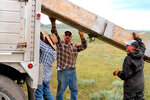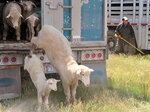Cloudy, 60° F
WIND RIVER RANGE FOOTHILLS—Kristy Wardell donned rain gear though the skies were clear.
The lifelong rancher was dressed in protective garb to guard against manure and urine that 366 ewes …
This item is available in full to subscribers.
The Powell Tribune has expanded its online content. To continue reading, you will need to either log in to your subscriber account, or purchase a subscription.
If you are a current print subscriber, you can set up a free web account by clicking here.
If you already have a web account, but need to reset it, you can do so by clicking here.
If you would like to purchase a subscription click here.
Please log in to continue |
|





WIND RIVER RANGE FOOTHILLS—Kristy Wardell donned rain gear though the skies were clear.
The lifelong rancher was dressed in protective garb to guard against manure and urine that 366 ewes and 442 lambs had discharged along the wheeled journey around the Winds. On her hands and knees, the 59-year-old crawled into the bowels of a big rig she’d driven to flush out the animals, which will summer on Jim Magagna’s pastureland along the banks of Lander Creek.
Not used to being trucked, the band “had an attitude” and were tough to budge. “These sheep I have trouble with every spring,” Wardell said.
For the better part of an hour she stayed at it, a shepherd on all fours in tight quarters pulling legs, prodding and doing whatever it took to guide gobs of damp sheep toward the exit ramp. Simultaneously, somehow, it was dusty, with enough sheep dander and dirt in the air to cause at least one onlooker’s eyes to clam up.
Wardell, though, was unfazed. Her dirty trucking task is essentially a side hustle. She’s a sheep rancher, heading the Thoman Ranch’s livestock operations in the Green River basin.
“The profitability is not there, you fall behind and you can’t pay your bills,” she said. “On our ranch I hardly even draw a wage. That’s why I drive my truck.”
At one time the Thoman Ranch ran 8,000 to 9,000 head of sheep. Then it was 5,000 or 6,000. Then 4,000.
“Now we’re down to 1,200,” Wardell said, “because you can’t get good help.”
In the modern domestic sheep world, such tales come pretty easy. It’s an industry in Wyoming that’s fallen off more than 90% since its heyday almost a century ago. In the old days, the Wyoming Wool Growers Association would hold a festive annual get-together, with a big supper and dance and other activities. That went away. This summer, however, the organization aimed for a resurgence, hosting the inaugural Wyoming Wool and Sheep Festival in Kemmerer.
“We’re just trying to get back to that, and celebrate the industry,” said Mike Curuchet, president of the Wool Growers board.
During a sheepherder panel on the opening night, however, talk of the tough times remained.
“It’s a struggle,” Cokeville sheep rancher Jon Child told the crowd. “We had to drop our market on our lambs last year, and it just makes you wonder whether to stay in it? We’re either crazy or we love it, and I think it’s probably we love it.”
Goal? Survive
Asked of their desired legacy, the panelists were on the same page: They just want to maintain.
“I want a legacy to pass on to the next generation,” Kemmerer sheep rancher Dave Julian said, “that’s my biggest goal.”
The same long-lasting inverted low-elevation snowpack that delivered mass death to mule deer and pronghorn also did a number on western Wyoming’s sheep ranchers. It was a “gut punch” to the industry, University of Wyoming sheep specialist Whit Stewart said.
More than one woolgrower called Stewart and ran through their numbers — the ewes they lost, expected lambing rates — trying to determine if they could break even.
“They said, ‘Can I do this?’” Stewart said. “It’s not often that I have to say, ‘If you can’t get to this production or reduce predation by this much, you’ve just gotta get out.’”
For the Thoman Ranch, this winter was costly. In a mild year, Wardell said, the family’s flock can survive just by browsing forage growing off their ranchland, supplemented with a little bit of corn. This year they also fed 3.5 pounds of hay per head daily from the onset of January clear through the month of April.
“Never ever have we had to feed that long,” Wardell said.
On the plus side, Curuchet said, lambs are looking quite a bit better this spring than they did a year ago. There are other silver linings within the long-suppressed industry that have the Wool Growers board president upbeat.
“I think there’s a lot of optimism,” he said. “There’s some really good people working on some really important issues right now that could hopefully make things a little better.”
Stewart, the UW professor, ran over some of the more encouraging industry trends.
“We’ve almost doubled our [domestic] lamb consumption,” he said. “That’s a statistic that you just don’t hear cited.”
There are also some increases in the aggregate number of sheep-growing operations, Stewart said. Because of the decline of large operations like the Thomans, total sheep numbers in Wyoming were still on the downswing as of 2018, the last time the U.S. Department of Agriculture’s National Agricultural Statistics Service completed its census. But smaller “farm flocks” are on the upswing: Nationally, one-to-100 head sheep operations have grown 40% since 2002, Stewart said.
“You can look at it and say, ‘Well, it’s an industry in decline,’” he said. “I look at it as an industry in transition. From the ‘50s to the early 2000s, you could say it was declining, but we’ve really stabilized.”
Chance for growth
Some Wyoming sheep ranchers new to the game are also accessing novel markets. Rancher Sage Askin, who grows non-woolbearing “hair sheep” — used only for their meat — added a flock to his Lusk-area operation a decade ago to supplement his cattle.
“We felt that we had browse and additional forage that our cattle were not utilizing on the ranches where we operate,” Askin said. “Very quickly it became apparent that the sheep were roughly twice as profitable, over a 10-year timespan, as cattle.”
Now Askin runs 4,000 sheep, plus keeps a herd of 1,000 goats.
Askin achieved profitability with his sheep partly by bucking industry norms and trying new tactics. He doesn’t send his animals ready for market to Colorado’s big processing plants.
“I see a lot of clients buying sheep for solar-panel grazing,” he said, “I see them buying for targeted grazing projects, and [I see] a lot of smaller producers [buying who] raise farm flocks of sheep.”
Askin’s male lambs and rams “almost exclusively” get sold to smaller-scale “ethnic buyers” for meat.
“What we’re doing, I would say, is very unorthodox and very unconventional,” he said.
Other sheep ranchers more dependent on conventional markets, like the Thomans, are holding out hope that the weather, pricing and other wool-growing variables take a turn in their favor.
“Mom and dad, they went through a lot of ups and downs, and they held on,” Wardell said.
The family, she said, has discussed selling their flock, but for now she’ll do what it takes to hold on — even if it’s trucking sheep and “getting four hours of sleep a night.”
“I don’t want to sell them, I want to keep the legacy going,” Wardell said. “I’ll do whatever it is to stay in it.”
During the sheepherders panel, her sister, Mary Thoman, threw out another idea for supplementary income that could keep the family on their land: “We may have to become fishing guides.”
Her niece, Taylor Thoman — part of the fifth generation of Thomans to run sheep — sat alongside her. The teenage Thoman had a quick retort to her aunt.
“Well, if I become a fishing guide,” she joked, “we’ve already lost the whole ranch.”
(WyoFile is an independent nonprofit news organization focused on Wyoming people, places and policy.)